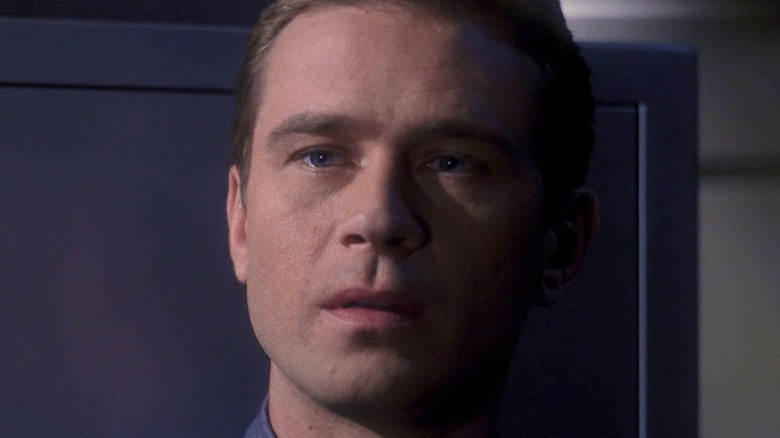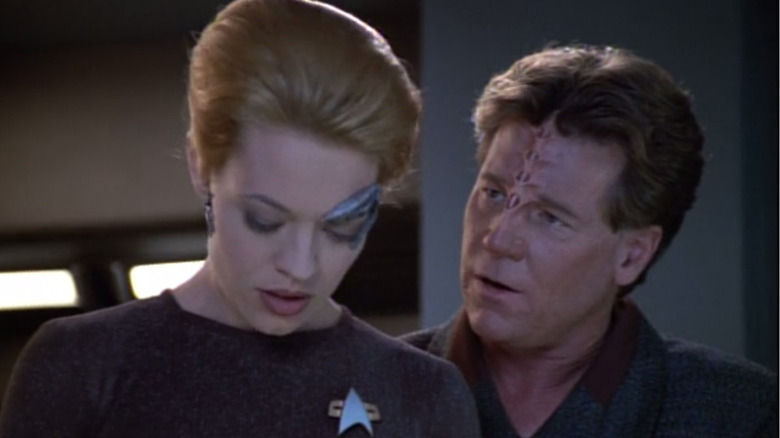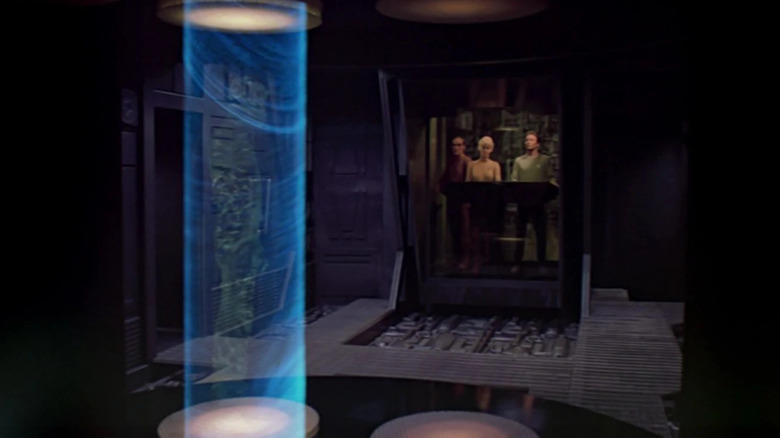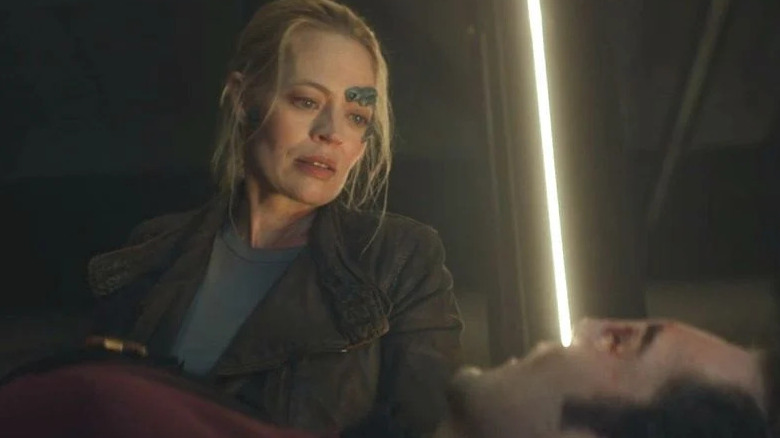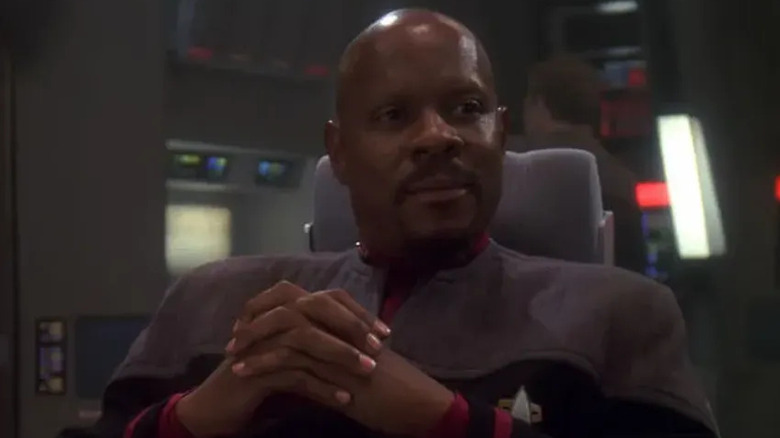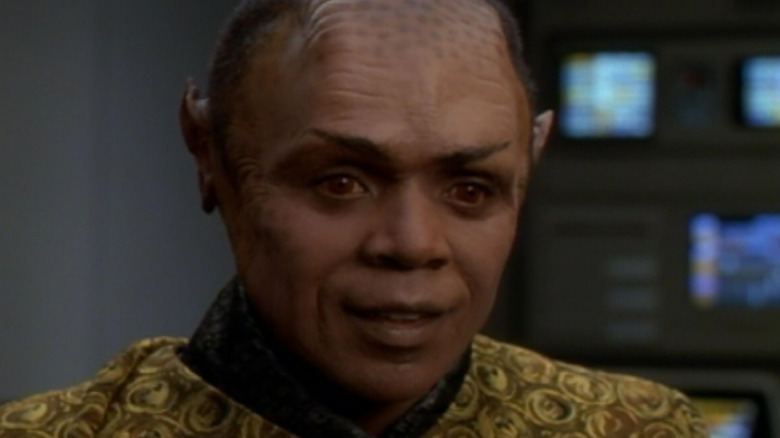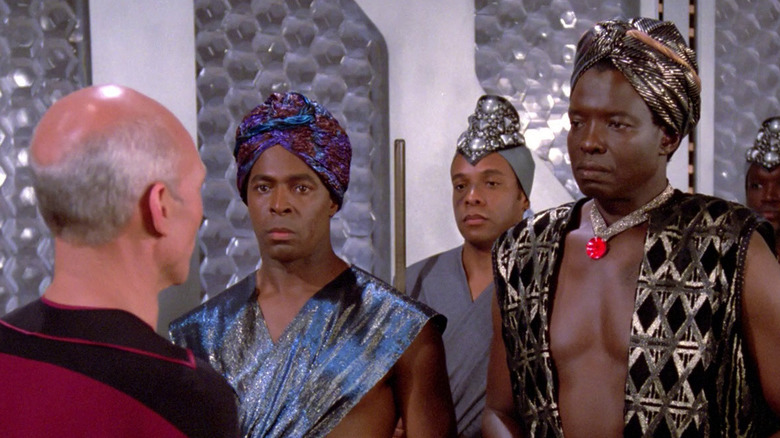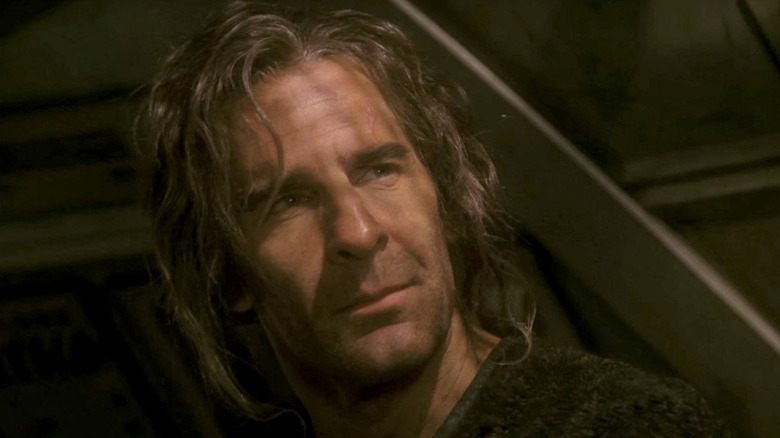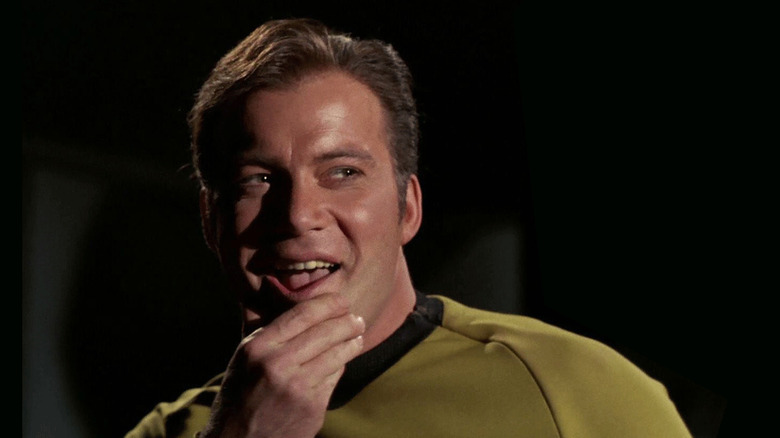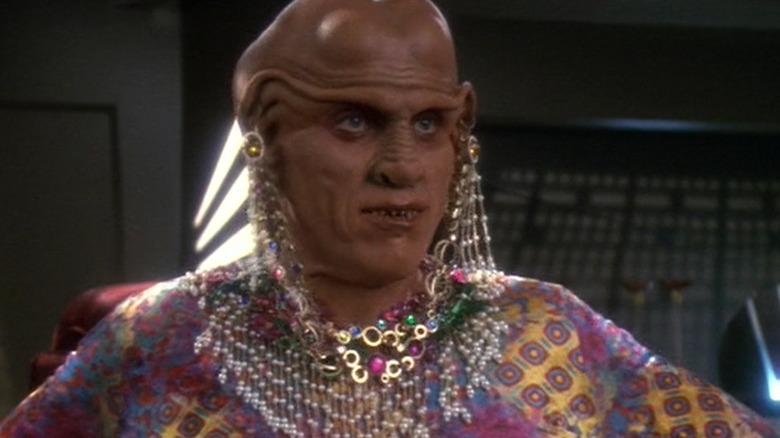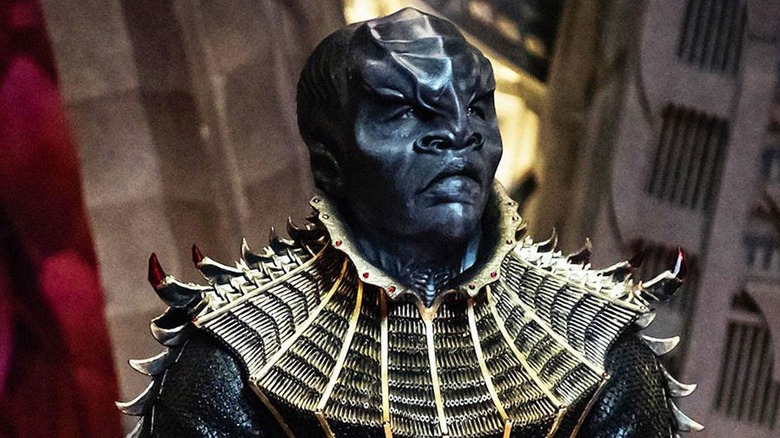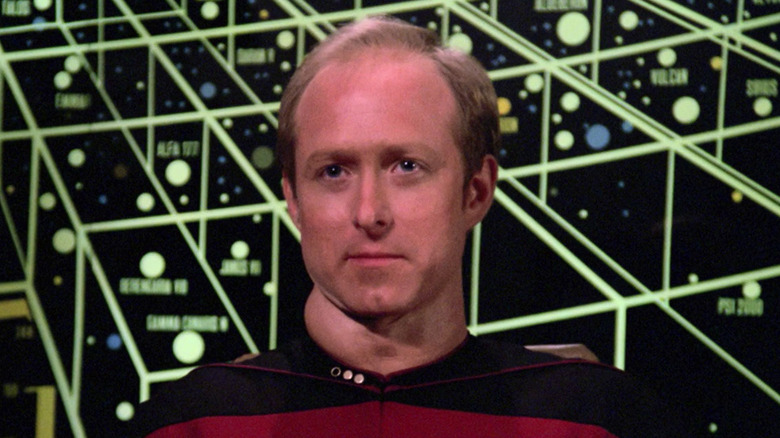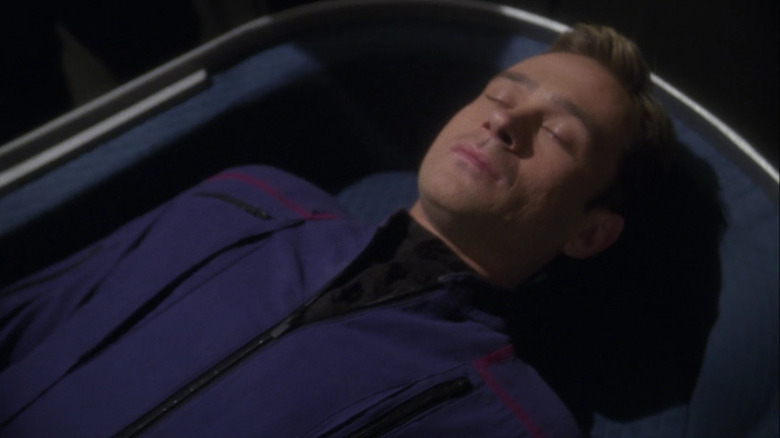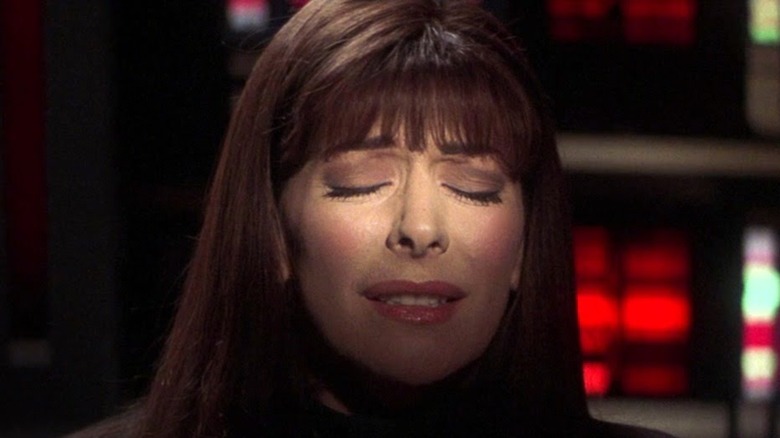Times Star Trek Went Too Far
For more than fifty years, "Star Trek" has been the rare franchise that has attracted audiences across the spectrum, with shows designed to appeal to kids and adults. "The Next Generation" was a quintessential show for all ages in the '80s and '90s; The recently-debuted "Star Trek: Prodigy" is an animated series aimed at kids; and "Star Trek: Picard" is geared more towards mature audiences.
But whether it's for children or their parents, even "Star Trek" has been known to go too far on occasion. Whether that's a moment of shocking graphic violence, or an exploitative sex scene, the "Trek" franchise has had dark spots that weren't for the faint of heart. These were moments that stood out from the rest of the story, leaving audiences gasping and saying "wow, they really went there." It hasn't been often, but with over 800 episodes, there were bound to be times when "Star Trek" went too far. We've put together a list of moments that should probably never have made it to air.
Victim Blaming Seven of Nine
"Star Trek" has rarely shied away from addressing sensitive and controversial subjects, and the "Voyager" episode "Retrospect" is no exception, with Seven being assaulted in an obvious rape allegory. The attack occurs when a merchant works with Seven on the installation of a weapons system aboard Voyager. During their time together he expresses interest in the nanoprobe technology that powers Seven's Borg implants, and is told that they are not for sale.
But after Seven is knocked unconscious from a power surge, she finds herself in sickbay. The Doctor helps her recover repressed memories of Kovin forcibly extracting the nanoprobes against her will. While there are many moments in "Retrospect" that speak to the real traumas faced by victims of sex crimes, "Star Trek: Voyager" goes a bit too far with the premise. They turn what could have a powerful episode about sexual assault and how allegations are too often ignored, into a story about the wrongful accused, and how recovered memories can spark false allegations. Despite the fact that study after study has shown that false accusations are the overwhelming minority, "Retrospect" chose not to focus on an important issue, and found itself sending all the wrong messages.
If you or someone you know has been the victim of sexual assault, you can report it by calling the National Sexual Assault Hotline 1-800-656-4673.
Transporter body horror
"Star Trek: The Motion Picture" was the first live-action glimpse at Kirk, Spock, McCoy and the Enterprise audiences had gotten in a decade. It ushered in a new era of family friendly movies and television shows, which would run uninterrupted for more than twenty five years. But one moment in "The Motion Picture" to this day still stands as darker and more horrifying than anything else seen in the franchise over that span, mostly because of how out of place it seems in the G-Rated film.
With the Enterprise undergoing its refit, two officers — including new Vulcan science officer Sonak, who audiences may have thought would be replacing Spock on the bridge — are beamed up to the ship. But the transporter malfunctions and deforms the pair into a terrifying mass of half-transported flesh, and the blood-curdling cries of agony from the victims can be heard echoing through the transporter room. Thankfully, the audience is spared a graphic look at the results as they are beamed immediately back to Earth where the transporter chief tells us "What we got back didn't live long ... fortunately." It's shocking to say the least that a child-friendly, G-rated movie would portray such a meaninglessly horrific moment.
Everybody hates Icheb
When "Star Trek: Picard" was first announced in 2019, Patrick Stewart warned fans during a university visit that it might not be the continuation of "Star Trek: The Next Generation" they expected, noting that "people will be surprised and perhaps even shocked." And shocked they were when "Star Trek: Voyager" fan-favorite character Icheb — the escaped Borg child from the Delta Quadrant who returned home with the ship to the Federation — was unceremoniously killed off in the opening moments of "Stardust City Rag." Not only did many fans see it a slap in the face to kill off the beloved character, but the manner in which they did it went too far.
The episode opens with the story's villain Bjayzl brutally torturing Icheb, now a Starfleet Lieutenant, ripping out his eye in a gorey and graphic scene that saw her forcibly tearing out his Borg implants to sell for profit. The irony is that she is seeking his cortical node, which Icheb gave to Seven when her life was in danger in the "Voyager" episode "Imperfection" – meaning if not for Seven, he may have been spared if she'd been able to more simply remove it. It's a nice bit of continuity, and Icheb's death does help serve to motivate Seven's character appropriately. That said, the blood-soaked torture scene — with Icheb's visceral, cringe-inducing screams — seemed woefully out of place and unnecessarily graphic, even for the more adult-skewing "Picard."
Sisko's genocidal gambit
We've seen Sisko taking morally gray actions in the past, but in those instances his actions are usually justified with grave consequences, or millions of lives being on the line. There's little such justification in his actions in "For The Uniform," though, with Sisko's reasons for going too far being almost entirely based on a personal vendetta. It all starts in the episode "For the Cause" when long-time Starfleet security chief is revealed as a Maquis terrorist. Captain Sisko takes this betrayal hard, not just because Eddington defected from Starfleet but because he never suspected Eddington's duplicity.
So when we get to "For the Uniform," Sisko is on the hunt for Eddington, and makes it very clear that this is personal. Eddington didn't just betray Starfleet, he betrayed Sisko, and the captain can't handle that fact that Eddington beat him in their first encounter. Now, with Eddington threatening to poison an entire Cardassian planet, Sisko goes way too far to catch his prey, destroying the ecosystem of an entire Maquis world to get Eddington to surrender, nearly wiping out an entire population of the planet. Though the Maquis would be able to escape and find a new home, his actions betrayed every Starfleet ideal, could have resulted in a massive death toll if it went wrong, and should have seen him at least court martialed for his actions.
The Tuvix Problem
In an episode that dealt with issues of identity, Vulcan security chief Tuvok is caught in a transporter accident with the ship's chef Neelix. Unlike the horrific accident in "The Motion Picture" the pair aren't deformed, but merged into one new, sentient being: Tuvix. Logical like Tuvok and carefree like Neelix, he's an entirely new person, and a compelling character in his own right who under other circumstances he might have been a welcome full time addition to the show.
But The Doctor discovers a way to reverse the accident and bring back Tuvok and Neelix. The only problem is that it would mean essentially killing Tuvix, who refuses the procedure on the grounds that he's his own person now, and entitled to exist. Even the Doctor says it's a violation of his medical ethics to perform the procedure, leaving Captain Janeway to do it — against Tuvix's protests. A heartbreaking moment occurs on the bridge when Tuvix begs someone, anyone, to stand up and stop the captain from killing him. Surprisingly, nobody does. Now we all know that Tuvix wasn't going to stick around and replace two series regulars. But why not go out heroically, offering to sacrifice himself to bring back Tuvok and Neelix because of some crisis? Instead, the writers chose to have the captain callously murder Tuvix for her own selfish reasons.
That TNG episode
"Code of Honor" is almost too obvious an addition to this list. It's been spoken about over and over, and those involved with the early first season episode of "Star Trek: The Next Generation" have mentioned their regret and embarrassment over it one many times over the years. But "Code of Honor" is simply too far over the line of decency to ignore.
And its a lot more than just one scene, moment, or character that goes too far. The entire episode is packed with racism and misogyny, with the backwards alien culture portrayed by all black actors with heavy accent — and sans any big alien makeup — fighting to the death in primitive ritual combat over a white woman. And there's seemingly no lesson here, no moral dilemma or ethical problem that justifies what we see. There was no attempt to use racial stereotypes to tell the audience about the awful truth of intolerance, either, which might have mitigated the uncomfortable nature of the portrayal. What's worse, it's just a poorly written, poorly acted, and just all-around bad episode, making it an easy skip on any "TNG" rewatch.
Archer's dark turn during the Xindi war
On "Star Trek: Enterprise," Captain Archer was a Kirk-like leader who would command an away mission and was unafraid to buck protocol — a man who'd just as soon sock an alien in the jaw as fire his phasers at their ship. But, like Kirk, he was also a morally upstanding captain. He always tried to do the right thing, help those in need, and see the best in every situation, no matter how dire it may have looked.
That's why his dramatic shift during the third season's "Xindi War" story arc was so striking, and crossed the line for many fans. When a mysterious alien race commits an unprovoked attack on Earth, killing millions, the Enterprise is dispatched to find the Xindi. During the story, Archer goes from a man who always does the right thing, to a violent captain willing to break every Starfleet rule and moral in service of revenge. They try to justify his actions by saying that the Xindi are intent on wiping out all of humanity, but on an episode-by-episode basis it often doesn't add up, torturing captives and stealing from innocent ships. Produced in a post-9/11 world, Archer's turn mirrored many real life shifts in public thinking at the time, but for "Star Trek", known for its unyielding optimism, it went too far. There were other options than corrupting one of Starfleet's greatest captains.
When Kirk was a woman
In the final episode of the original series, "Turnabout Intruder" sank as low it could go into the waters of misogyny. Captain Kirk encounters his ex-lover, Janice Lester, and there are problems right away when she says "Your world of Starship captains doesn't admit women." Fans have sometimes interpreted this as Starfleet now allowing women to be captains — and they may be right, as she implies that it's why she has never been able to achieve a command position.
She uses a strange device to swap bodies with Kirk, forcing her former lover to "know the indignity of being a woman," additionally noting that "it's better to be dead than live alone in the body of a woman." Over the course of the story, Lester-as-Kirk — intent on killing the crew — attempts to rule the Enterprise with a conniving, petty fist. She turns the tough, skilled, respected Captain Kirk into a petulant and whiney brat, sending the message that women are incompetent and incapable of leadership, while men alone are strong, proficient, and worthy of command. No one has ever figured out if this was Roddenberry's own bias, his knee-jerk reaction to the growing feminist movement, or simply a bad script gone wrong, but it goes way, way too far.
When Quark was a woman
If you thought "Turnabout Intruder" was bad, the "Star Trek: Deep Space Nine" episode "Profit and Lace" is even worse. It's very premise is appallingly sexist. Rather than use the sexist state of Ferengi culture to provide commentary on sexism in the real world, "Profit and Lace" plays on the worst gender stereotypes. It makes a mockery not just of women, but of the LGBTQ community, and trans people specifically. The episode uses a gender swap as a plot device for Quark to get what he wants, from a procedure that Doctor Bashir inexplicably goes along with without any hesitation. And even though the writers try to have Quark learn a lesson about how to treat women, even that scene is ruined with the implication that it's only the residual results of his transition, while his female employee is sad she can't be sexually exploited.
While it is noble that the show tried to say something about women's rights — on Ferenginar at least — it's still the men who get the job done. And though some have defended it in recent years, it's an episode that should never have made it off the drawing board for a number of reasons. It's a farcical episode that plays on stereotypes, and we're comfortable saying it will never make anyone's "Top Star Trek Episodes" list.
Most of Discovery's First Season
With the disappointing cancelation of "Star Trek: Enterprise" in 2005, the franchise left television screens for the first time in twenty years. It would be twelve more before it returned, with the debut of the long-awaited "Star Trek: Discovery" in 2017. Another prequel, the series is set just ten years before the original series era of Captain Kirk, and saw a previously unseen but highly advanced starship battling enemies in the long talked-about Klingon war. But while it's not without its bright spots, the first season of "Star Trek: Discovery" went too far for many fans of the franchise.
For starters, the visual look of the series was a wild departure from the original, with far more advanced technology than should have existed just a decade before Kirk and Spock. The makeup for the Klingons was a wild departure as well and upset many longtime fans. But most surprising of all, the tone of the series was darker, more visceral, and more mature than what the series had ever been, even the modern update from J.J. Abrams. From graphic sex and violence to weepy melodrama and adult language, "Discovery" saw "Trek" become less than family friendly. The second season lightened the mood somewhat, and many felt it was a big improvement, while the third removed it from the confines of its previous setting, showing that the producers may have come to agree with early fan reaction.
TNG goes Scanners
"Star Trek: Discovery" wasn't the first time the franchise had returned to television after a decade plus absence. "Star Trek: The Next Generation" too marked the long-awaited return of "Star Trek" to living rooms, and was aimed at the same family audience as the original. The new series was once again a bright, colorful, optimistic look at the future with a crew who all got along, and fought for peace and equality throughout the galaxy. But first season episode "Conspiracy" gave audiences a darker story than they have expected, a story that in hindsight would probably have been better suited to future spin-off "Deep Space Nine."
In an unsettling opening, Picard is warned of a dire threat. He is told that something is wrong at Starfleet, and it goes all the way to the top. The conspiracy comes to the Enterprise when a high ranking Admiral tries to kill Commander Riker and implant him with an alien bug that will control his mind. In the climax, the leader of the interstellar invasion — Commander Remmick — is revealed as the mastermind, and Picard and his first officer confront him at Starfleet Headquarters. Fully revealed, Picard and Riker proceed to blow his head apart with phaser fire, and eviscerate his upper torso in a graphic scene that likely horrified the family audiences watching in prime time in 1987.
When Enterprise went organ harvesting
The episode "Similitude" ranks high on IMDb's list of the series' 98 episodes. And it's well earned: it's a powerful episode, one that sees Tucker terminally wounded, and a clone created to help restore him to life. While the clone gets accustomed to life on the ship, he bonds with the crew in some of the most beautiful moments of the series. It's also the episode where T'Pol learns that Tucker is in love with her, taking their ongoing relationship story to the next level.
The problem, however, is that the clone of Tucker is created for the sole purpose of using his organs to give to the original to cure his illness, with the unique form of cloning resulting in a being whose lifespan is just two weeks. It's an ethical problem discussed only briefly, and they once again use the Xindi War to try to justify their creation of the clone knowing it will die in days. But while the heartbreaking life and death of the "Sim" clone is what makes the episode great, we can't help but feel that bringing a life into being simply to harvest it for its organs was a bit too dark, and too far. It could have been more interesting if the clone brought about more discussions over the implications of genetic cloning, but instead it seems like a cheap, manipulative plot device to pull at the audience's heartstrings.
Sleazy Ex-Troi-tation
Even with the twenty years that passed since the original "Star Trek," the followup series "Star Trek: The Next Generation" wasn't immune to misogyny. Too often, the women of the Enterprise were not given weak episodes. Nowhere was this more evident than with Counselor Troi, who was most often either shown as incompetent ("Disaster"), bratty ("The Loss"), obsessed with food ("The Game"), or being distracted by a romantic conquest ("Man of The People," "Tin Man," and "Masterpiece Society"). She was the victim of assault or bodily violation on more than one occasion ("The Child," Violations"), but it reached its worst moment in "Star Trek: Nemesis."
In the film, Troi serves little purpose than to become the target of the villain's sexual aggression, and Shinzon (played by Tom Hardy), uses the help of a powerful Reman servant to invade Troi's mind and engage in telepathic sexual assault. It's an element that really has no place in the film, as we already understand how vile Shinzon is, and it seems solely motivated by the producer's desire for a sex scene, and perhaps to give Troi something to do. But maybe making Troi a victim once again isn't the meaty "Star Trek" character arc they think it is.
